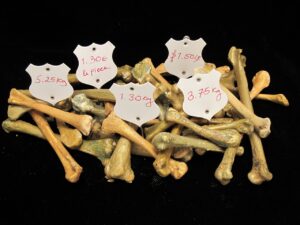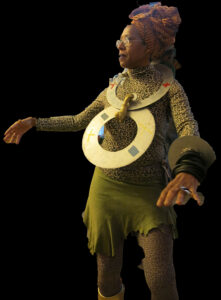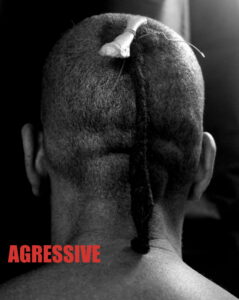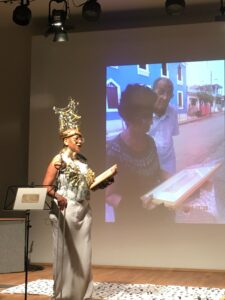Prix AWARE

Cheryl Ann Bolden, The cost, 2011, bones, meat price tag, © Cheryl Ann Bolden

Cheryl Ann Bolden, Forest Altar, 2012, bones, local natural material, wales, © Cheryl Ann Bolden
Artist, collector and archivist, Cheryl Ann Bolden is the descendant of six generations of African-Americans1. Her artistic practice is primarily based on objects which carry memory. She works with original objects and documents which bear witness to the trade of enslaved people as well as to the periods of segregation and colonialism in the United States and in Europe. Her practice is made up of the following gestures: performing, assembling, archiving and transmitting.

Cheryl Ann Bolden, Space body, 2020, metal, bone, plastic, © Cheryl Ann Bolden

Cheryl Ann Bolden, Installation in Cuba, 2014, at El Cimarron, tree, slave document, © Cheryl Ann Bolden
For C. A. Bolden, the work of archiving is born form material and immaterial heritage: “I consider my body as an archive, as an art-work”. A performance-artist, she interrogates and “reactivates” this link between the body – her body – and the physical traces of history. In 2014, during a visit to Cuba, she performed libations with rum at the base of secular trees found on the former sites where people reduced to slavery were sold, important sites of collective memory. Placed on the visible roots at the foot of a tree, a document showing the purchase of enslaved people is witness to this gesture. One can nonetheless question if one can ask the archives to speak entirely for themselves, since they detail reality without ever describing it2. Through the act of archiving and performing, C.A. Bolden would enrich these archives, bringing a vital texture to them.
In his book Between the World and Me, the American writer Ta-Nehisi Coates considers that black bodies do not completely belong to those who wear them3. Coates defends the idea that, due to past and present violence, that they are still seen and treated as if they were devoid of subjectivity, and, ultimately, of humanity. The destruction of black bodies is, he argues, a legacy4. Regularly referencing the maternal line of her family, C.A. Bolden treats the question of the transmission of traumatic experience through different channels: direct narration, inherited objects, and subjective corporeal memory5.

Cheryl Ann Bolden, Stereotypical Statements about Black Women, 2020, black and white photography, © Cheryl Ann Bolden

Cheryl Ann Bolden, Performance at the INHA, janvier 2023 © Cheryl Ann Bolden
By “reactivating” objects normally destined for a museum environment, C.A. Bolden gives the public – issued from the diaspora or not – the possibility of reappropriating these elements and their memory, in an intimate and, paradoxically, dedramatised way: touching and considering the real weight of a solid iron ankle chain, acquired in an antique shop in Normandy; deciphering the English bill of sale for three horses and two “negroes” bought by the same owner at the end of the 19th century; witnessing the evolution of the representation of black faces, from a book destined for Dutch children from over 100 years ago to American and French postcards portraying non-white bodies in a stereotyped, even animalistic way.
C.A. Bolden is also known for her work Precious Cargo Museum. It is a travelling structure and teaching project dedicated to the transmission of the history and culture of the African diaspora to the young, in order to activate the collective dimension of this past, commonly seen as belonging to one sole group.
The artist allows speech to liberate itself through these objects. And, through this liberation, a certain healing takes place. In her sculpture Afro Healing (2001), needles are placed on a volume of Afro-textured hair. C.A. Bolden detects the painful spot, pierces it, and lets the pain seep away until it disappears. Or, better still, until it metamorphoses.
Danilo Lovisi
Cheryl Ann Bolden was born in 1957 in Newark, New Jersey, USA. An artist, collector and archivist, she has lived and worked in Paris since the late 1990s. The gestures that constitute her practice are performing, assembling, archiving and transmitting. C. A. Bolden has a multidisciplinary background, having studied art and design at the Corcoran School in Washington, textile design and weaving at the Fremantle Art Center in Fremantle, Australia, and acupuncture at the New England School of Acupuncture in Massachusetts. She has travelled extensively and lived in Mexico, Germany, China, Australia, Portugal, Great Britain and many African countries. These experiences have not only enriched her outlook, but have also nourished her collection of original objects and documents which relate to the history of the colonial and segregationist periods, both in the United States and in Europe.
The artist prefers this term to that of Afro-Americans.
2
Farge Arlette, Le Goût de l’archive, Paris, Seuil, 1989.
3
Coates Ta-Nehisi, Between the World and Me, New York, Spiegel & Grau, 2015
4
“the police departments of your country have been endowed with the authority to destroy your body. It does not matter if the destruction is the result of an unfortunate overreaction […] Sell cigarettes without the proper authority and your body can be destroyed […] Turn into a dark stairwell and your body can be destroyed. The destroyers will rarely be held accountable. […] All of this is common to black people. And all of this is old for black people. No one is held responsible.” Coates Ta-Nehisi, op. cit. p.9. In My Grandmother’s Hands: Racialized Trauma and the Pathway to Mending Our Hearts and Bodies (Las Vegas, Central Recovery Press, 2017), Resmaa Menakem invites readers to recognise that experiencing racism involves not only the spirit but also the body. He shows how we can overcome our so-called “racial” differences, well-ingrained, by becoming conscious of the fact that the body is the place where our instincts reside and where the trauma inflicted by the wrongs that plague society is endured.
5
In The Body Keeps the Score: Brain, Mind, and Body in the Healing of Trauma (New York, Viking Penguin, 2014), the psychiatrist Bessel Van der Kolk explains his research on the effects of traumatic experiences on the body, whether these are micro-traumas or traumas due to war. He studies the different ways in which the body is affected by them and develops the idea of what he calls “transgenerational trauma”: traumatic experience transmitted in a hereditary manner.
Translated from French by Eléonore Besse.
Tous droits réservés dans tous pays/All rights reserved for all countries.






